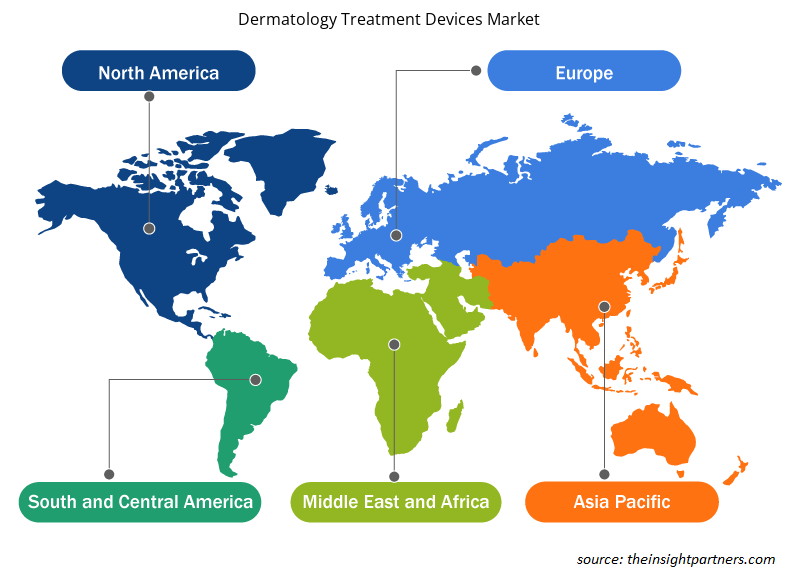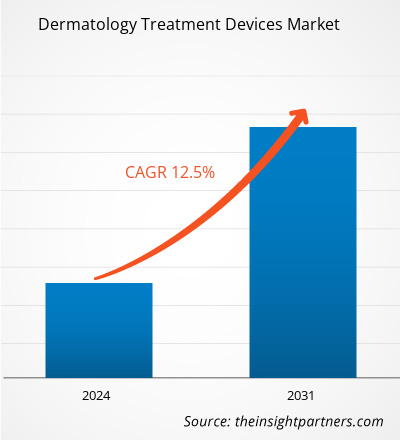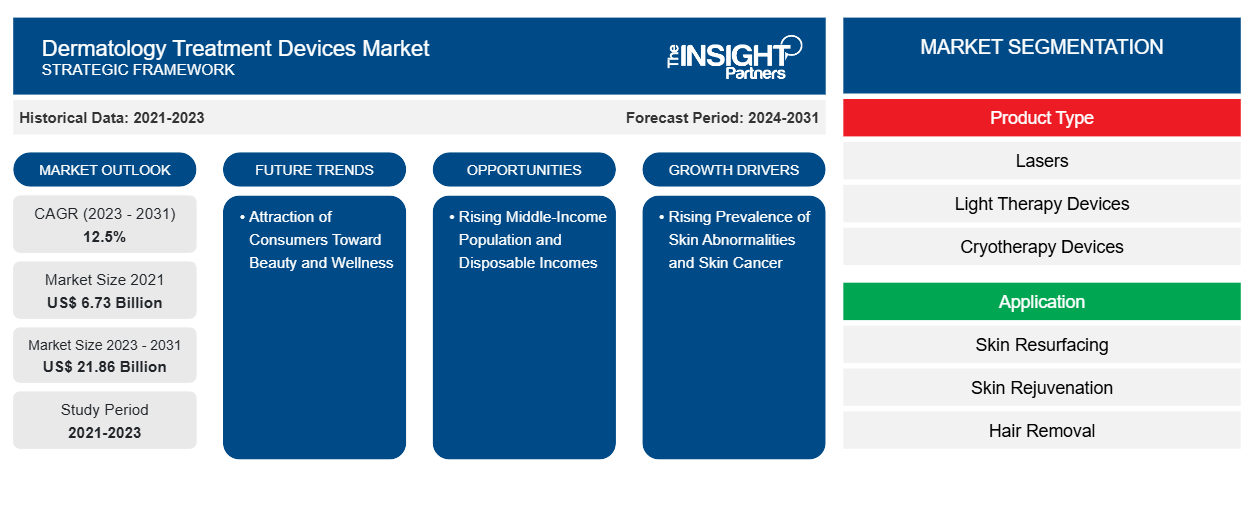Der Markt für dermatologische Behandlungsgeräte wurde im Jahr 2021 auf 6,73 Milliarden US-Dollar und im Jahr 2023 auf xx Milliarden US-Dollar geschätzt. Es wird erwartet, dass er bis 2031 21,86 Milliarden US-Dollar erreicht und bis 2031 eine durchschnittliche jährliche Wachstumsrate von 12,5 % verzeichnet. Dermatologische Geräte für den Heimgebrauch, die Integration von KI in dermatologische Geräte und die Entwicklung dermatologischer Geräte mit benutzerdefinierten Einstellungen werden voraussichtlich die wichtigsten Trends auf dem Markt für dermatologische Behandlungsgeräte bleiben .
Marktanalyse für dermatologische Behandlungsgeräte
Die zunehmende Verbreitung von Hautkrankheiten wird voraussichtlich das Wachstum des Marktes für dermatologische Behandlungsgeräte vorantreiben. Altersbedingte Hautprobleme wie Pigmentierung, Falten, Fältchen und Akne sowie Brandnarben durch Unfälle sind bei den meisten Menschen weit verbreitet. Laut dem National Center for Complementary and Integrative Health leidet jeder dritte Amerikaner an Hautkrankheiten. Darüber hinaus erkrankt laut der Skin Cancer Foundation jeder fünfte Amerikaner bis zum Alter von 70 Jahren an Hautkrebs und in den USA sterben stündlich über 2 Menschen an Hautkrebs. Diese Hautkrankheiten erfordern kritische medizinische Eingriffe und dermatologische Geräte für ihre therapeutische Behandlung, um schwere Zustände zu bekämpfen, was das Wachstum des Marktes für dermatologische Behandlungsgeräte wahrscheinlich weiter vorantreiben wird.
Marktübersicht für dermatologische Behandlungsgeräte
Der globale Markt für dermatologische Behandlungsgeräte ist nach Regionen unterteilt in Nordamerika, Europa, Asien-Pazifik, Naher Osten und Afrika sowie Süd- und Mittelamerika. Das Marktwachstum in dieser Region wird aufgrund von Faktoren wie der zunehmenden Verbreitung von Hautproblemen und technologischen Fortschritten bei dermatologischen Behandlungsgeräten erwartet, die das Wachstum des Marktes ankurbeln werden. Das Risiko unerwünschter Nebenwirkungen im Zusammenhang mit der Verwendung dermatologischer Behandlungsgeräte dürfte jedoch das Marktwachstum behindern.
Passen Sie diesen Bericht Ihren Anforderungen an
Sie erhalten kostenlose Anpassungen an jedem Bericht, einschließlich Teilen dieses Berichts oder einer Analyse auf Länderebene, eines Excel-Datenpakets sowie tolle Angebote und Rabatte für Start-ups und Universitäten.
-
Holen Sie sich die wichtigsten Markttrends aus diesem Bericht.Dieses KOSTENLOSE Beispiel umfasst eine Datenanalyse von Markttrends bis hin zu Schätzungen und Prognosen.
Markttreiber und Chancen für dermatologische Behandlungsgeräte
Technologische Fortschritte bei dermatologischen Behandlungsgeräten werden den Markt begünstigen.
Weltweit werden kontinuierlich Forschungs- und Entwicklungsstudien durchgeführt, um hautbezogene Erkrankungen besser zu verstehen. Unternehmen investieren in die Entwicklung neuer und innovativer medizinischer Geräte, um einen guten Return on Investment (ROI) zu erzielen. Darüber hinaus bestätigt die Zulassung durch die Aufsichtsbehörden die Zuverlässigkeit und Glaubwürdigkeit der neuartigen Produkte und medizinischen Geräte zur Hautbehandlung. So stellte beispielsweise Nu Skin Enterprises, ein weltweit führendes Unternehmen im Bereich Schönheit und Wellness, im Februar 2024 Nu Skin RenuSpa iO vor, ein Mikrostrom-Körpergerät, ein intelligentes Schönheits- und Wellnessgerät, das durch Hautstimulation das allgemeine Wohlbefinden und den Körper fördern soll.
Steigende Bevölkerung mit mittlerem Einkommen und verfügbares Einkommen – eine Chance auf dem Markt für dermatologische Behandlungsgeräte
Laut der Europäischen Union wird die globale Mittelschicht bis 2030 voraussichtlich 5,3 Milliarden Menschen erreichen, und die asiatische Bevölkerung wird wahrscheinlich an der Spitze dieser Entwicklung stehen. Bis 2030 werden China und Indien voraussichtlich etwa 66 % der globalen Mittelschichtbevölkerung und 59 % des Mittelschichtkonsums ausmachen. Die Vergrößerung der Mittelschicht mit erheblichen Veränderungen im Verbraucherverhalten und in den Konsummustern wird wahrscheinlich die wirtschaftliche Entwicklung vorantreiben. Darüber hinaus gab das US Bureau of Labor Statistics an, dass das verfügbare Einkommen in den USA von 10.036,9 Milliarden US-Dollar im Jahr 2006 auf 21.858,08 Milliarden US-Dollar im Jahr 2021 gestiegen ist.
Marktbericht zu dermatologischen Behandlungsgeräten – Segmentierungsanalyse
Wichtige Segmente, die zur Ableitung der Marktanalyse für dermatologische Behandlungsgeräte beigetragen haben, sind Dienstleistungen und Anwendungen.
- Basierend auf dem Produkttyp ist der Markt für dermatologische Behandlungsgeräte in Laser, Lichttherapiegeräte, Kryotherapiegeräte , Mikrodermabrasionsgeräte, energiebasierte Therapiegeräte und Mikronadelung unterteilt. Das Lasersegment hielt im Jahr 2023 den größten Marktanteil, während das Segment der Lichttherapiegeräte im Prognosezeitraum voraussichtlich die höchste durchschnittliche jährliche Wachstumsrate auf dem Markt verzeichnen wird.
- Der Markt ist nach Anwendung segmentiert: Hauterneuerung, Hautverjüngung, Haarentfernung, Psoriasis, Narben, Warzen und Hautflecken, Hyperpigmentierung und Gefäßläsionen, Akne, Tattooentfernung und Hyperhidrose. Das Segment Hautverjüngung hatte 2023 den größten Marktanteil, während das Segment Haarentfernung im Prognosezeitraum voraussichtlich die höchste durchschnittliche jährliche Wachstumsrate (CAGR) auf dem Markt verzeichnen wird.
- Nach Endverbraucher wurde der Markt für dermatologische Behandlungsgeräte in Krankenhäuser, SPA-Kliniken, dermatologische Kliniken und chirurgische Zentren segmentiert. Die dermatologischen Kliniken hielten 2023 den größten Marktanteil, und es wird geschätzt, dass dasselbe Segment im Prognosezeitraum die höchste durchschnittliche jährliche Wachstumsrate (CAGR) auf dem Markt verzeichnet.
Marktanteilsanalyse für dermatologische Behandlungsgeräte nach Geografie
Der geografische Umfang des Marktberichts zu dermatologischen Behandlungsgeräten ist hauptsächlich in fünf Regionen unterteilt: Nordamerika, Asien-Pazifik, Europa, Naher Osten und Afrika sowie Südamerika/Süd- und Mittelamerika.
Nordamerika umfasst die USA, Kanada und Mexiko. Der nordamerikanische Markt hatte im Jahr 2023 einen bedeutenden Anteil am Weltmarkt. Die Nachfrage nach dem Markt in der Region wird im Prognosezeitraum voraussichtlich aufgrund verschiedener Faktoren wie der steigenden Nachfrage nach fortschrittlichen technologiebasierten Dermatologielösungen, der zunehmenden Häufigkeit von Hautkrankheiten, technologischen Fortschritten im Bereich der Dermatologie, die durch FDA-Zulassungen unterstützt werden, und der Präsenz namhafter Marktteilnehmer deutlich wachsen.
Der asiatisch-pazifische Raum ist der am schnellsten wachsende Markt für dermatologische Behandlungsgeräte weltweit, was auf die große Bevölkerung von Ländern wie China und Indien, die zunehmende Konzentration der Marktteilnehmer und die Einführung neuer Produkte oder Therapien im Land zurückzuführen ist. Darüber hinaus tragen die steigende Zahl von Hauterkrankungen, das wachsende Bewusstsein für kosmetische Verfahren zur Verbesserung der Ästhetik, die steigenden Gesundheitsausgaben und die Verfügbarkeit technologischer Fortschritte bei dermatologischen Geräten dazu bei, das Wachstum des Marktes für dermatologische Behandlungsgeräte in der Region anzukurbeln.
Regionale Einblicke in den Markt für dermatologische Behandlungsgeräte
Die regionalen Trends und Faktoren, die den Markt für dermatologische Behandlungsgeräte während des gesamten Prognosezeitraums beeinflussen, wurden von den Analysten von Insight Partners ausführlich erläutert. In diesem Abschnitt werden auch die Marktsegmente und die Geografie für dermatologische Behandlungsgeräte in Nordamerika, Europa, im asiatisch-pazifischen Raum, im Nahen Osten und Afrika sowie in Süd- und Mittelamerika erörtert.

- Erhalten Sie regionale Daten zum Markt für dermatologische Behandlungsgeräte
Umfang des Marktberichts zu dermatologischen Behandlungsgeräten
| Berichtsattribut | Details |
|---|---|
| Marktgröße im Jahr 2021 | 6,73 Milliarden US-Dollar |
| Marktgröße bis 2031 | 21,86 Milliarden US-Dollar |
| Globale CAGR (2023 - 2031) | 12,5 % |
| Historische Daten | 2021-2023 |
| Prognosezeitraum | 2024–2031 |
| Abgedeckte Segmente |
Nach Produkttyp
|
| Abgedeckte Regionen und Länder |
Nordamerika
|
| Marktführer und wichtige Unternehmensprofile |
|
Marktteilnehmerdichte für dermatologische Behandlungsgeräte: Auswirkungen auf die Geschäftsdynamik verstehen
Der Markt für Dermatologie-Behandlungsgeräte wächst rasant, angetrieben von der steigenden Endverbrauchernachfrage aufgrund von Faktoren wie sich entwickelnden Verbraucherpräferenzen, technologischen Fortschritten und einem größeren Bewusstsein für die Vorteile des Produkts. Mit steigender Nachfrage erweitern Unternehmen ihr Angebot, entwickeln Innovationen, um die Bedürfnisse der Verbraucher zu erfüllen, und nutzen neue Trends, was das Marktwachstum weiter ankurbelt.
Die Marktteilnehmerdichte bezieht sich auf die Verteilung von Firmen oder Unternehmen, die in einem bestimmten Markt oder einer bestimmten Branche tätig sind. Sie gibt an, wie viele Wettbewerber (Marktteilnehmer) in einem bestimmten Marktraum im Verhältnis zu seiner Größe oder seinem gesamten Marktwert präsent sind.
Die wichtigsten Unternehmen auf dem Markt für dermatologische Behandlungsgeräte sind:
- Cutera Inc.,
- Bausch Health Companies Inc.,
- Sciton, Inc.,
- Lumenis,
- Alma Lasers,
- Anziehungspunkt,
Haftungsausschluss : Die oben aufgeführten Unternehmen sind nicht in einer bestimmten Reihenfolge aufgeführt.

- Überblick über die wichtigsten Akteure auf dem Markt für dermatologische Behandlungsgeräte
Marktnachrichten und aktuelle Entwicklungen zu Geräten zur dermatologischen Behandlung
Der Markt für dermatologische Behandlungsgeräte wird durch die Erhebung qualitativer und quantitativer Daten nach Primär- und Sekundärforschung bewertet, die wichtige Unternehmensveröffentlichungen, Verbandsdaten und Datenbanken umfasst. Im Folgenden finden Sie eine Liste der Entwicklungen auf dem Markt für dermatologische Behandlungsgeräte und -strategien:
- Im Oktober 2021 stellte Lutronic, der weltweit führende Anbieter energiebasierter Systeme für die medizinische Ästhetik, Derma V vor, eine bahnbrechende dermatologische Workstation. Derma V ist ein dermatologischer Laser, den Hautspezialisten für ihre tägliche Arbeit – Gefäß-, Pigment- und Verjüngungsbehandlungen – in einer einzigen, leistungsstarken und benutzerfreundlichen Technologie benötigen. Vor der Einführung von Derma V mussten Dermatologen mit verschiedenen Technologien jonglieren und von einem speziell entwickelten Laser zu einem anderen wechseln, um das richtige Werkzeug für den richtigen Eingriff zu verwenden. Dabei gingen oft Wirksamkeit und Sicherheit zu Lasten von Geschwindigkeit und Benutzerfreundlichkeit oder umgekehrt. (Quelle: Pressemitteilung des Unternehmens)
- Im Februar 2023 brachte MTG Co., Ltd. das „ReFa DERMA HEAT“ auf den Markt, ein Gesichtsgerät, das mit seiner einzigartigen „DERMA HEAT“-Technologie die gleichzeitige Wirkung von hochfrequenter Vibrationswärme und -kühlung ermöglicht. (Quelle: Pressemitteilung des Unternehmens)
Marktbericht zu Geräten zur dermatologischen Behandlung – Umfang und Ergebnisse
Der Bericht „Marktgröße und Prognose für dermatologische Behandlungsgeräte (2022–2030)“ bietet eine detaillierte Analyse des Marktes, die die folgenden Bereiche abdeckt:
- Marktgröße und Prognose auf globaler, regionaler und Länderebene für alle wichtigen Marktsegmente, die im Rahmen des Projekts abgedeckt sind
- Marktdynamik wie Treiber, Beschränkungen und wichtige Chancen
- Wichtige Zukunftstrends
- Detaillierte PEST/Porters Five Forces- und SWOT-Analyse
- Globale und regionale Marktanalyse mit wichtigen Markttrends, wichtigen Akteuren, Vorschriften und aktuellen Marktentwicklungen
- Branchenlandschaft und Wettbewerbsanalyse, einschließlich Marktkonzentration, Heatmap-Analyse, prominenten Akteuren und aktuellen Entwicklungen
- Detaillierte Firmenprofile
- Historische Analyse (2 Jahre), Basisjahr, Prognose (7 Jahre) mit CAGR
- PEST- und SWOT-Analyse
- Marktgröße Wert/Volumen – Global, Regional, Land
- Branchen- und Wettbewerbslandschaft
- Excel-Datensatz
Aktuelle Berichte
Erfahrungsberichte
Grund zum Kauf
- Fundierte Entscheidungsfindung
- Marktdynamik verstehen
- Wettbewerbsanalyse
- Kundeneinblicke
- Marktprognosen
- Risikominimierung
- Strategische Planung
- Investitionsbegründung
- Identifizierung neuer Märkte
- Verbesserung von Marketingstrategien
- Steigerung der Betriebseffizienz
- Anpassung an regulatorische Trends























 Kostenlose Probe anfordern für - Markt für dermatologische Behandlungsgeräte
Kostenlose Probe anfordern für - Markt für dermatologische Behandlungsgeräte